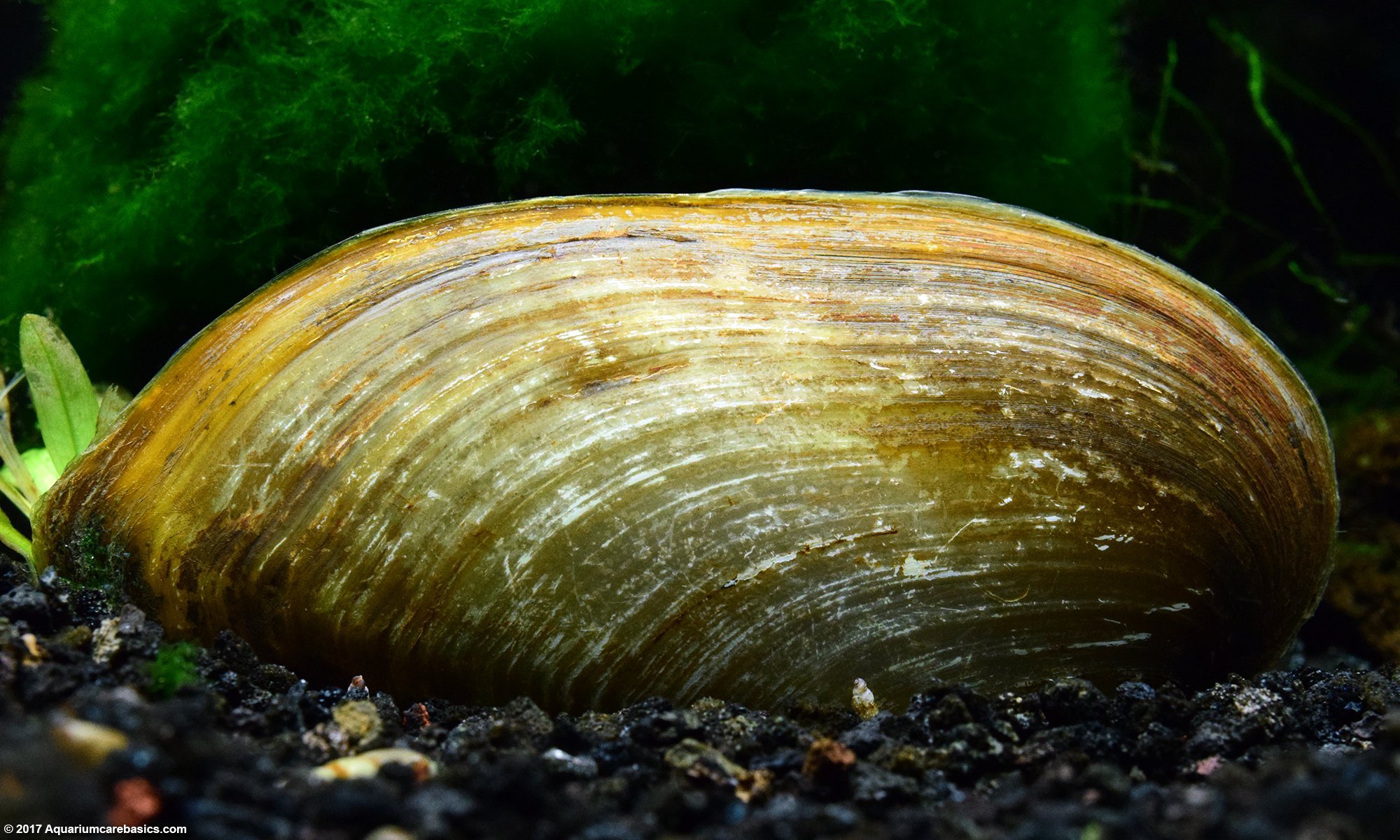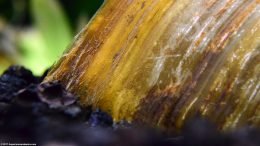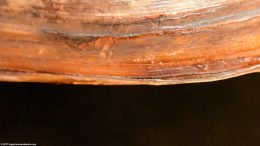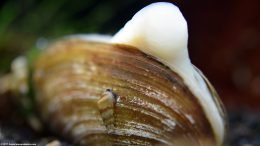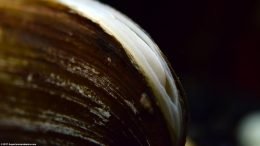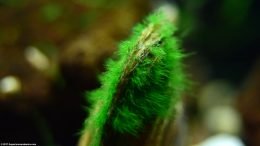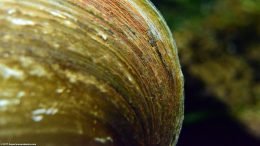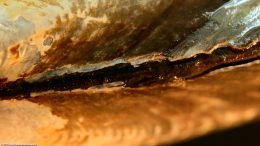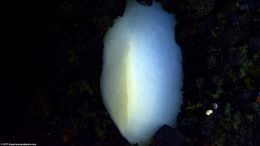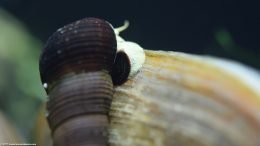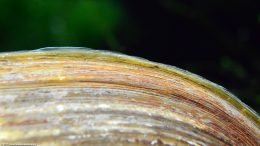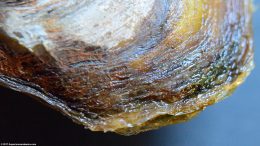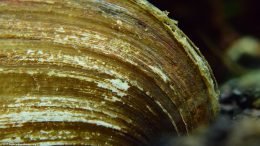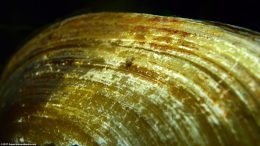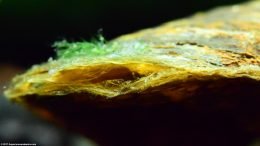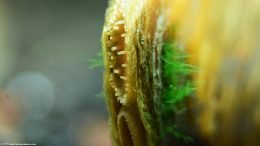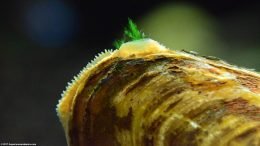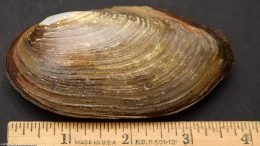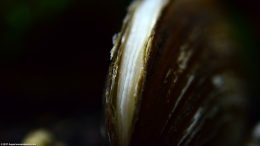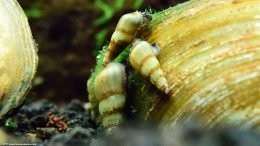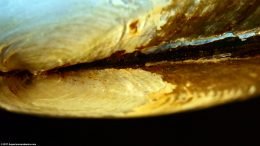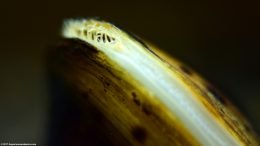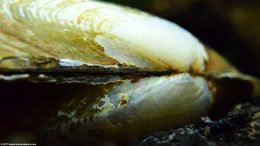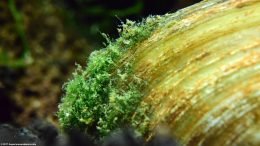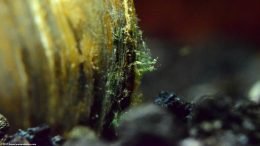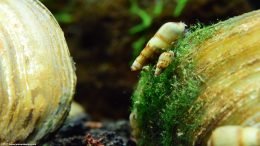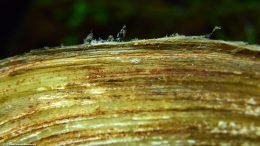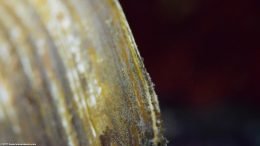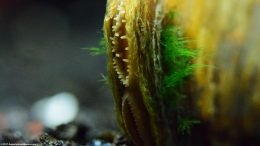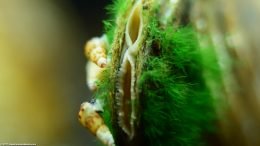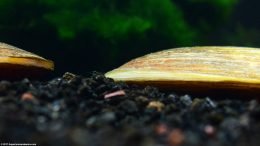An Asian Gold Clam can be a unique and interesting conversation piece in a freshwater aquarium. Like other freshwater clams, an Asian Gold Clam is peaceful in disposition, content to find a spot to feed, and remain there for days on end.
Observing Asian Gold Clam Behavior
An Asian Gold Clam will spend most of its time partially buried in fine substrate on the tank bottom. In many cases, an Asian Gold Clam will be between half way and three quarters buried. In some cases, the clam will be completely buried. But even if completely buried, an Asian Gold Clam can be observed slowly borrowing through the substrate. The substrate actually moves. It’s not uncommon for an active Asian Gold Clam to travel around the perimeter of a tank over time. Another interesting thing to see is that different clams can behave differently. One clam may be content burying itself half way, while another clam will consistently bury itself completely. The same goes for movement. One clam may always be content to stay in one spot, while another clam may always be on the move. These behavioral differences can really be interesting to observe.
Asian Gold Clam Images
An Asian Gold Clam is generally gold, light brown or tan in color. Their shells are oblong in shape compared to other more round freshwater clams. Their shells have a grooved texture resulting from their growth rings. An Asian Gold Clam has an inhalant siphon and an exhalent siphon used to move water in and out for feeding and respiration. Both siphons have filament-like appendages surrounding their perimeter. The appendages are sensitive to touch. An Asian Gold Clam also has a large powerful white foot used to move throughout the tank.
When Buying An Asian Gold Clam In Stores
When buying an Asian Gold Clam, look for clams that are resting on the tank bottom. A healthy clam shell should be free from cracks, pits, extensive erosion, or other deformities. Shell damage may be an indication the clam has been in less than ideal water conditions for long periods of time. The clam shell should be either closed, or slightly open with their siphons and soft tissue slightly visible. Since Asian Gold Clams are slow moving and live on the tank bottom, its not uncommon for shells to be partially covered with patches of green algae or fibrous green plant matter.
Avoid buying Asian Gold Clams if they floating, if their shells are open more than a crack, or if the interior of the clam can be seen. These can be indications the clam is dead or dying. Also avoid buying Asian Gold Clams from display tanks with an usually high number of dead or dying tank mates, as this can be an indication unhealthy water conditions. Along these lines, avoid buying clams from tanks with cloudy water. Milky white water can be an indication that a clam has died, is decomposing and causing an ammonia spike. Finally, make sure the closed shell is not empty. Its not uncommon for closed, empty clam shells to be accidentally sold as being alive. An empty clam shell will feel very light, and water will pour from it when it is removed from a tank.
Asian Gold Clam Care: Moderate
As long as some basics are in place, Asian Gold Clam care should be pretty straightforward. While Asian Gold Clam care is not necessarily easy, it need not be difficult either. Asian Gold Clam care issues involve: water parameters, water current, tank size, habitat, feeding, and tank mates.
Established Tank Parameters
Its important to make sure the clam is being kept in a filtered, completely cycled and fully established tank. Make sure water parameters stay stable within a healthy range. Its also important to make sure there is sufficient edible matter in the water column to support the clam’s nutritional needs. Finally, make sure the water current is moving quickly enough to keep sufficient edible matter floating throughout.
Aquarium pH: 7.0 to 8.0, to avoid shell erosion
Water Temperature: 70 – 85 Degrees Fahrenheit, slightly cooler is possible
Hardness: Water on the hard side
Lighting: Standard community tank lighting is sufficient
Ammonia and Nitrites should be kept at 0 ppm. Nitrate levels should be kept low with regular partial water changes. Also, be careful with additives. Medications, and plant fertilizers may contain substances harmful to clams. This is particularity true with Copper. Even in low amounts, Copper can be harmful or fatal to clams. Double check to make sure additives are clam safe.
Aquarium Size & Habitat
Tank Size: A filter feeding Asian Gold Clam needs to be in a tank with sufficient size and capacity to support its life. A 10 gallon tank is too small. While some hobbyists suggest that a 15 gallon tank is sufficient for one Asian Gold Clam, the better choice is to keep it in a tank that is 29 gallons, and up. The tank should have plenty of fine substrate on the tank bottom. The substrate should be deep enough for the clam to burrow.
Habitat: An Asian Gold Clam can be kept in tanks with lots of live plants. Shedding plants can create a constant supply of edible debris for clams to eat. But with Asian Gold Clams and live plants, be prepared for a clam to inadvertently uproot a plant now and then as it borrows under the substrate.
Calcium Is Important
Feeding & Diet: An Asian Gold Clam should be able to meet its nutritional needs by siphoning established tank water. This is especially true in well planted tanks containing otherwise well-fed inhabitants. But even if the tank seems able to support the nutritional needs of an Asian Gold Clam, it may be a good idea to offer pinches of Calcium rich, commercial food supplements on occasion. Food supplements should be finely ground fish flakes, bottom feeder tablets, fish pellets, algae wafers, or other invertebrate food.
Clam Size & Lifespan: A healthy Asian Gold Clam can grow quite large given proper tank conditions. In stores, Asian Gold Clams generally average between 3 and 3 1/2 inches in length. Its said in some cases, under the right conditions, Asian Gold Clams can grow to be about 8 inches in length.
An Asian Gold Clam can live a year or so in good conditions. Some hobbyists say they’ve had luck with clams living upwards of three years. Other hobbyists have had clams last about three of four months, and some die shortly after being introduced to a new tank. Its really hard to say much for sure regarding a clam’s lifespan, because alot has to do with water conditions, the clam itself, and plain luck. Its a good idea to hope for about one year, and if the clam lives longer, its a bonus.
Remove Dead Clams Immediately
Note regarding dead clams. Its very important to keep an eye out for dead clams. Remove a dead clam from a tank immediately. Decomposing clams can destroy tank water quality very quickly. Water can turn cloudy white and ammonia levels can shoot up, causing harm or death to other inhabitants. This especially important if the clam dies while buried. A dead buried clam may not be discovered until the water damage is done.
Tank Mates For Asian Gold Clams
An Asian Gold Clam is non-aggressive by nature. They have no ability to defend themselves except to close their shells. Keep Asian Gold Clams in a tank with others clams and other non-aggressive invertebrates. Filter feeding shrimp like Wood Shrimp and Viper Shrimp are good candidates. Other freshwater shrimp like Amano Shrimp, Ghost Shrimp and Red Cherry Shrimp make good tank mates as well. Freshwater snails like Nerite Snails, Trumpet Snails, Japanese Trapdoor Snails, Gold Inca Snails, Ivory Snails, Mystery Snails, Ramshorn Snails, Rabbit Snails and even Assassin Snails can also work out well.
If Asian Gold Clams are being kept in a community tank, most peaceful community tank fish should work, with Cory Catfish and Otocinclus Catfish being particularly safe choices. Just make sure the tank is not overstocked.
Avoid keeping Asian Gold Clams with tougher species such as Cichlids, Goldfish and aquarium crayfish. These can harm or kill clams. If there are any questions regarding clams and tank mate compatibility, be sure to check with the store clerk before buying.

